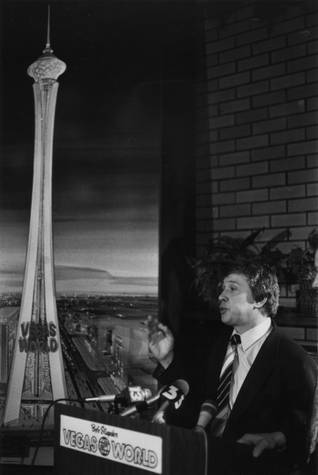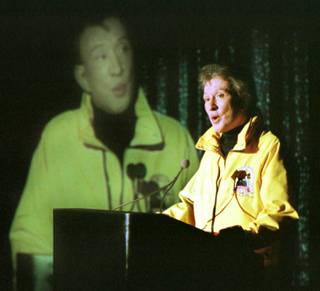
Tony Blei / Sun File Photo
Bob Stupak at the unveiling of the artist’s rendering of his casino tower at Vegas World, which would later become the Stratosphere, Feb. 1990.
Saturday, Sept. 26, 2009 | 2 a.m.
Sun Archives
Beyond the Sun
Asterisks in Bob Stupak's life
- Ran illegal card games as a teenager
- Served in the National Guard
- Raced motorcycles
- Performed as a nightclub singer under the name Bobby Star
- Bought the Sinabar lounge in downtown Las Vegas and renamed it The Vault.
- Leased the Glitter Gulch on Fremont Street, and erected the neon sign of Vegas Vicky, a potential cowgirl “mate” for the neon Vegas Vic
- Marketed a game called “Stupak: The Ultimate Game of Skill and Chance”
- Had Zsa Zsa Gabor perform at his old Vegas World casino showroom
- Dated Las Vegas entertainer Phyllis McGuire, with whom he recorded the Christmas song “Jake the Flake.”
- Appeared in a handful of television shows, including “Crime Story” in 1987
- Paid the Harlem Globetrotters basketball team $100,000 to play in a game with them for two minutes.
Streetwise and poker-savvy, abrasive and ambitious, Bob Stupak was the ultimate Las Vegas gambler and huckster, always pushing the envelope if it would bring him publicity.
He placed a million-dollar bet on the 1989 Super Bowl game and won. (Insiders say he quietly hedged his bet by also putting money on the other team.) He had the vision to build a futuristic space-themed casino and the ego to call it “Bob Stupak’s Vegas World.” He is credited with offering the first million-dollar slot machine jackpot, and redefined the Las Vegas skyline, literally, by erecting the tallest observation tower in the country — and topping it with carnival rides. And then he talked about building a casino fashioned after the Titanic — only bigger, with condo time shares nestled in the four towering smokestacks and a casino that would dominate the adjoining iceberg.
Former Las Vegas Mayor Jan Jones, who in 1996 was among Las Vegas City Council members who signed a proclamation naming Stupak “Mr. Las Vegas,” said, “There was only one Bob Stupak.”
“Right or wrong, Bob Stupak stood behind what he believed,” Jones, a Harrah’s Entertainment executive, said Friday. “He would not compromise for better or worse. He never apologized for himself, nor should he have.”
Robert E. “Bob” Stupak died Friday after a long battle with leukemia. He was 67.
Always the independent (his nickname was “the Polish Maverick”), he was more aggravating than charming, but always a topic of conversation, which pleased him.
“He thought of himself as larger than he was and could often come off as gruff and angry, especially if you disagreed with him,” said Howard Schwartz, operator of the Gamblers Book Shop. “Bob Stupak liked being controversial — he swam upstream. It was almost overkill how he tried to earn people’s respect, which he never truly got. People would smile and shake his hand then talk about him behind his back.”
Said Jones: “If Bob was wrong, he’d admit he was wrong. If he were right he’d tell you 10 times he was right.”
And longtime Las Vegas journalist Myram Borders, who covered Stupak during the years of his greatest contributions to local history, said Stupak “was always playing it right to the edge — good, bad or indifferent.”
Stupak was sometimes the survivor — like after a horrific motorcycle crash that crushed every bone in his face and left him in a coma 14 years ago — and sometimes the loser, running unsuccessfully to be the Las Vegas mayor, a Clark County commissioner and the Nevada lieutenant governor.
What he did win at was poker. A fixture at the old World Series of Poker at what is now Binion’s, in 1989 he won a $139,500 purse in the $5,000 buy-in no-limit deuce-to-7 world championship. He made the final table of that event three more times during his career.
“Bob was a decathlon gambler — sports bets, propositions, poker — everything at once,” said Las Vegas oddsmaker and gambler Lem Banker, who gave Stupak the advice to take Cincinnati plus 6 1/2 points in the 1989 Super Bowl against San Francisco for Stupak’s legendary $1 million winning bet. “He had a lot of heart and a lot of brains.”
But Banker and others say that bet was a publicity stunt, as Stupak also made another sizable bet at the same now-defunct gaming hall Little Caesar’s Sports Book.
“He was phenomenal at bringing attention to himself and his casino,” high-stakes poker player Mike Sexton said. “Once while flying home on the Concorde, he challenged Alaska gambler Perry Green to a heads-up poker game. When Stupak got back to Las Vegas he announced that he had just played in the highest poker game of all time.”
Stupak was born April 6, 1942, in Pittsburgh, the son of longtime illegal floating craps game operator Chester Stupak and his wife Florence.
At 22, Stupak, who didn’t attend school beyond eighth grade, arrived in Las Vegas, selling 2-for-1 coupon books for restaurants. He moved to Australia to operate the same business and a telemarketing firm, but was evicted from the country amid allegations of questionable business practices.
With about $300,000 in his bank account, Stupak returned to Las Vegas in 1971, bought a restaurant, discovered that wasn’t his calling and got a state gaming license. On March 31, 1974, he opened Bob Stupak’s World Famous Historic Gambling Museum on the Strip, just north of Sahara Avenue in a seedier part of town.
One of his quarter slots offered a $250,000 jackpot, and a nickel machine teased a $50,000 payout.
The place burned down two months later, and on the site he built his space-themed Vegas World — which he promoted around the world as a high-end resort, only to disappoint tourists who on the occasional rainy day would find buckets catching drips from the leaky roof.
Next door to Vegas World, Stupak built his 1,149-foot-tall Stratosphere — shorter than the 1,800-footer he wanted because the Federal Aviation Administration said any taller would interfere with planes delivering gamblers to Las Vegas.
The Stratosphere seemed a metaphor for Stupak’s life struggles: Its construction was stalled by a dramatic fire high in its pedestal that rained embers onto the street, and three months after its 1996 opening — and a year after he nearly died in a motorcycle crash — he resigned as chairman as the property was falling into bankruptcy.
It was after that when he pitched his Titanic casino, which Las Vegas city officials rejected.
Stupak’s bickering with city and county politicians, and his contention that he could do a better job, led to several blustery runs for public office and a stint at publishing his own maverick weekly newspaper, the Las Vegas Bullet.
In his inaugural run for mayor in 1987, he sent gift fruit baskets to potential voters. Stupak also financed the unsuccessful Las Vegas City Council campaigns of his daughter Nicole in 1991 and his son, Nevada, in 1999.
Stupak also was credited with helping to get his nurse-turned-girlfriend, Janet Moncrief, elected to Las Vegas City Council in 2003. She wound up being the only council member ever to be recalled from office. Stupak tossed his hat into the political arena for the last time in 2006, making a run for lieutenant governor of Nevada. He finished third, garnering 17 percent of the statewide vote.
In the late 1990s Stupak began helping charitable causes through his foundation, including opening a community center in one of the poorest areas of town.
For his philanthropic efforts, the Las Vegas City Council on Feb. 23, 1996, issued a proclamation citing Stupak for his “valuable pioneering efforts” and “his outstanding generosity ... in answering the call of children, the homeless and the underprivileged.”
In more recent years, a seemingly mellower Stupak kept a much lower profile, content to play in high stakes poker games at the Bellagio and other major Strip resort card rooms and shirking the limelight he once sought with much fervor. He also was seen occasionally on televised poker events, including a final table during the first season of the World Poker Tour.
Besides children Nevada and Nicole, Stupak is survived by another daughter, Summer; two sisters, Linda Phillips and Nancy O’Conner, and two former wives, Sandra Blumen and Annette Hatton.
No funeral services were planned.
Sun reporter Mary Manning contributed to this story.


Join the Discussion:
Check this out for a full explanation of our conversion to the LiveFyre commenting system and instructions on how to sign up for an account.
Full comments policy